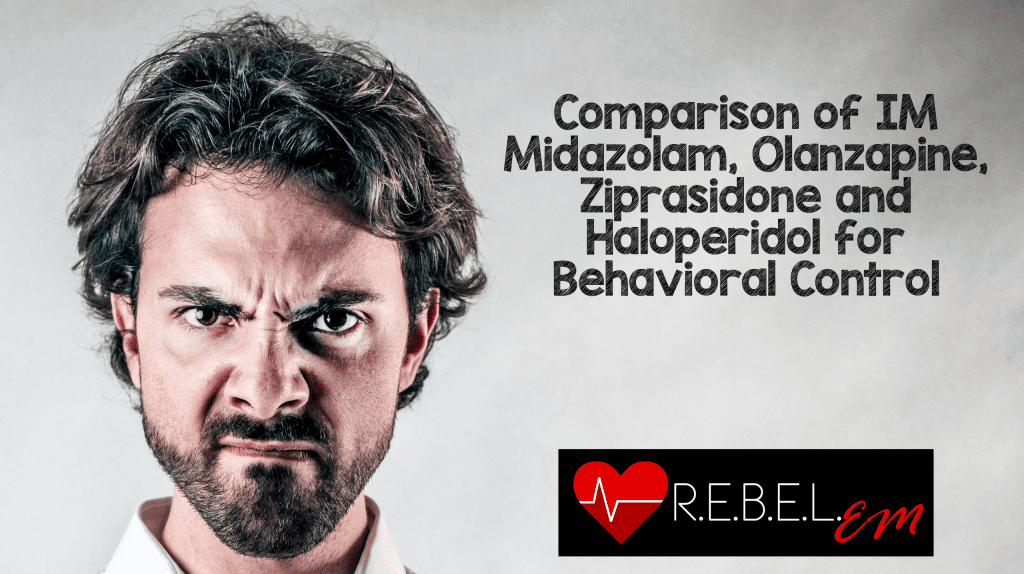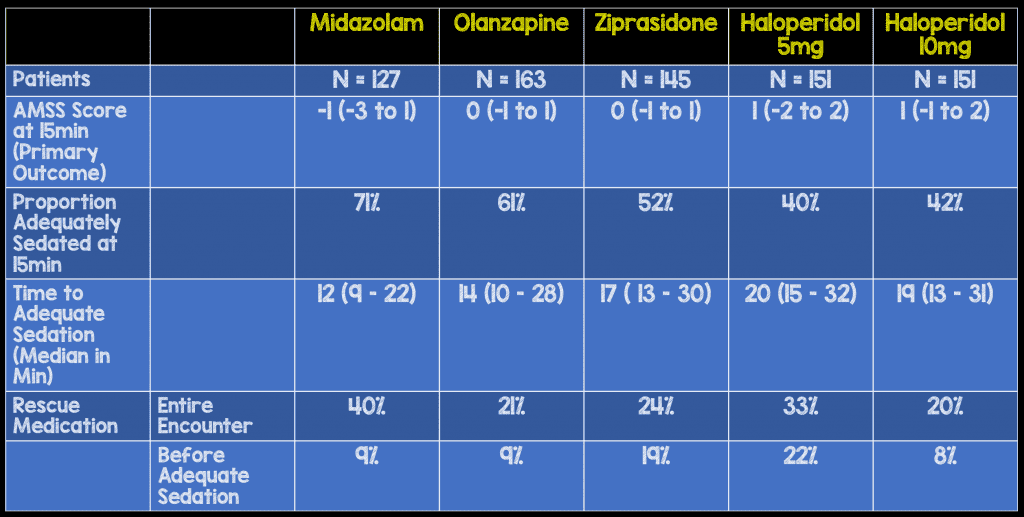
 Background: Emergency providers frequently care for agitated patients ranging from restlessness to verbally and physically aggressive. Agitation is a symptom, not a diagnosis and these patients require careful evaluation to rule in or out serious medical conditions. Unfortunately, the agitation itself often obstructs this evaluation and places the patient, other patients and staff at risk. While verbal de-escalation can be effective in select cases, administration of medications for behavioral control is often required. Numerous medications are available for this indication, but the optimal approach is still unclear.
Background: Emergency providers frequently care for agitated patients ranging from restlessness to verbally and physically aggressive. Agitation is a symptom, not a diagnosis and these patients require careful evaluation to rule in or out serious medical conditions. Unfortunately, the agitation itself often obstructs this evaluation and places the patient, other patients and staff at risk. While verbal de-escalation can be effective in select cases, administration of medications for behavioral control is often required. Numerous medications are available for this indication, but the optimal approach is still unclear.
Article:
Klein LR et al. Intramuscular midazolam, olanzapine, ziprasidone, or haldoperidol for treating acute agitation in the emergency department. Ann Emerge Med 2018. PMID: 29885904
Clinical Question:
What is the efficacy of five different medication regimens in the treatment of the agitated patient?
Population:
Patients > 18 years of age requiring medication to create acute agitation in the emergency department (ED) that presented during a 15 week period
Arms:
Haloperidol 5 mg, ziprasidone 20 mg, olanzapinne 10 mg, midazolam 5 mg and haloperidol 10 mg
Outcomes:
-
Primary: Altered Mental Status Scale (AMSS) at 15 minutes (see table in show notes) evaluated as proportion adequately sedated (AMSS < 1)
- Altered Mental Status Scale (AMSS) is a validated agitation scale win which scores range from -4 (most sedated) to 4 (most agitated).
- Secondary: Median difference AMSS score from baseline to 15 minutes, rescue medications administered (before and after adequate sedation achieved, time to adequate sedation and adverse events
Design: Prospective, observational study with prespecified 3-week treatment blocks
Excluded:
Patients < 18 years of age, prisoners or patients under arrest
Results:
-
3,443 patients screened for enrollment
- n = 737 patients included in analysis
- n = 64 (8%) patients who were missed by screening
- 72% of patients were men
- Alcohol intoxication (88%) most common cause of agitation
- Baseline AMSS scores similar between groups
Critical Results:

-
Comparison of Proportion Sedated
- Midazolam was the most effective medication at the 15 minute mark
- The dose of haloperidol did not make a significant difference in proportion sedated at 15 minutes in comparison to midazolam or olanzapine
- Adverse events were uncommon and there was no difference found

Strengths:
- Asks a clinically important question
- Powered study to detect an 18% difference with at least 635 patients enrolled and surpassed that enrollment target
- Broad inclusion criteria with minimal exclusion criteria
- Research assistants were available for enrollment 24 hours a day, 7 days a week
- Enrolled consecutive patients
- Only 8% of eligible patients were missed for enrollment
- Small number of protocol violations
- AMSS tool is validated for this indication
Limitations:
- The authors sought out to perform a prospective, double-blind, RCT (this was their initial registered plan on clinicaltrials.gov) but were unable to do so secondary to IRB and FDA approval issues
- Single center trial limiting external validity
- Homogenous patient population, with 72% male and 88% agitated secondary to alcohol intoxication
- Absence of blinding of treatment may have biased results as AMSS score has subjective components (unclear from manuscript if assessors of AMSS blinded)
- Absence of blinding may bias side effects reporting as clinicians recording side effects were aware of treatment allocation
- Due to only having a single research assistant available, patients may have been missed if multiple agitated patients presented simultaneously
- The study did not assess medication combinations which are commonly employed
- Vast majority of patients had alcohol intoxication. This creates problems for external validity depending on your population
Discussion:
- The median baseline level of agitation was mild to moderate (AMSS score = 2) in this study. This data is not be applicable to the severely agitated patient.
- Despite their attempts, the authors were unable to get an RCT with exception for informed consent as the FDA determined that agitated patients can provide meaningful consent
- While midazolam was the most likely medication to obtain adequate sedation at 15 minutes, it was also the medication mostly likely to require rescue medication. This difference was driven by the need for additional meds after obtaining adequate sedation.
- Extrapyramidal effects were rare in the haloperidol group (2/302)
Author’s Conclusions:
“Intramuscular midazolam achieved more effective sedation in agitated ED patients at 15 minutes than haloperidol, ziprasidone, and perhaps olanzapine. Olanzapine provided more effective sedation than haloperidol. No differences in adverse events were identified.”
Our Conclusion:
IM midazolam achieved the most rapid sedation of the agitated patient in this study. However, due to its short duration of action, patients receiving midazolam were more likely to require additional medications for sedation during their ED course. IM olanzapine was significantly more likely to achieve adequate sedation at 15 minutes than haloperidol (either 5mg or 10 mg).
Potential to Impact Current Practice:
If rapid sedation with a high chance for success with a single agent is desired, IM midazolam is your drug of choice. Olanzapine should be considered over haloperidol if available. This study does not add to our understanding of sedation of the severely agitated patient.
Bottom Line:
IM midazolam 5 mg achieves a high-success rate of sedation at 15 minutes with the caveat of increased need for additional medications during the ED course due to its short activity.
Post Peer Reviewed By: Jenny Beck-Esmay, MD (Twitter: @jbeckesmay) and Salim R. Rezaie, MD (Twitter: @srrezaie)
The post Comparison of IM Midazolam, Olanzapine, Ziprasidone and Haloperidol for Behavioral Control appeared first on REBEL EM - Emergency Medicine Blog.
